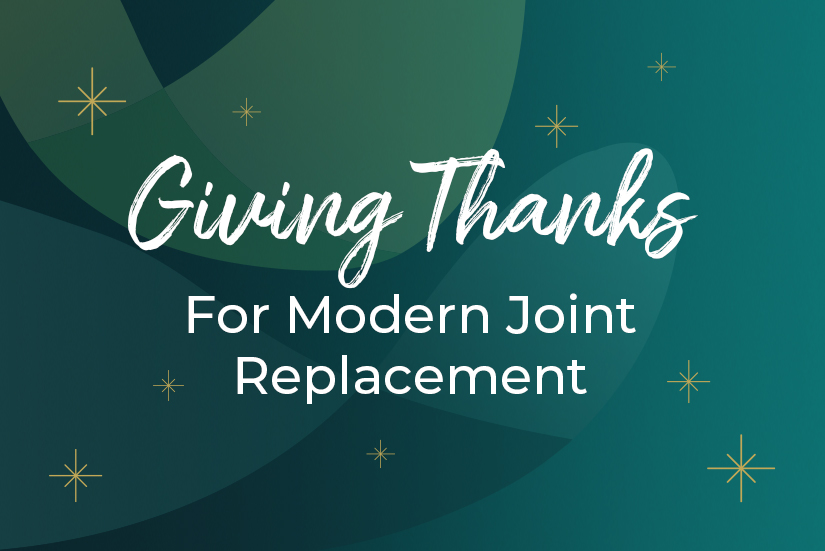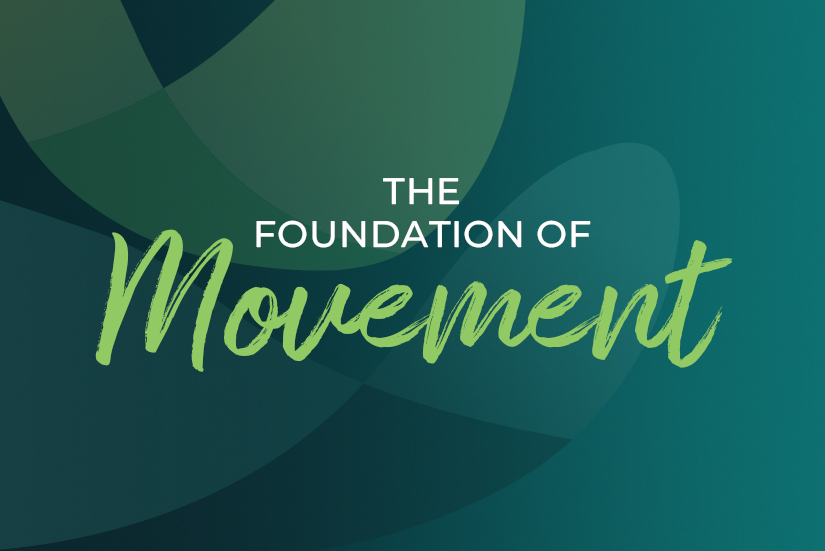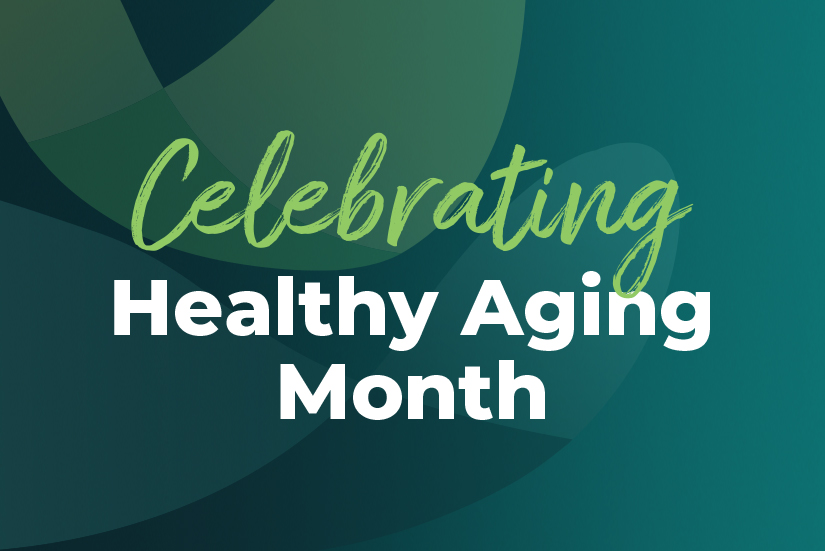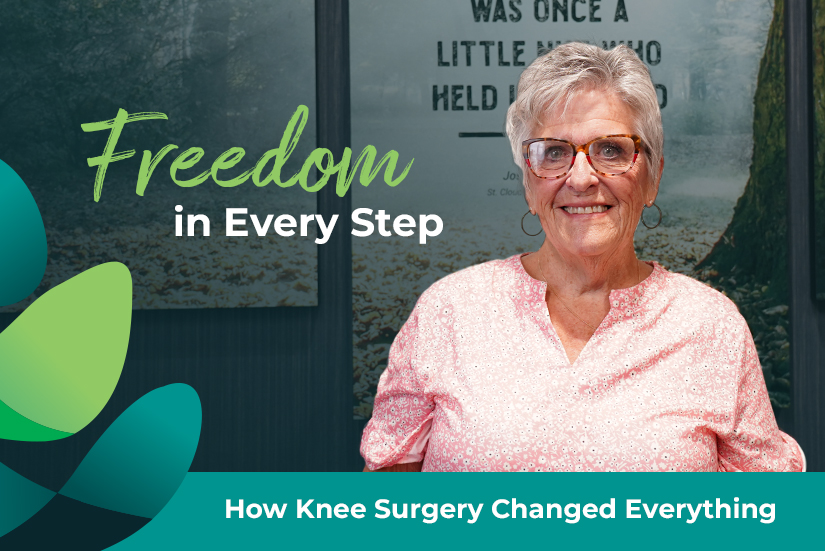Giving Thanks For Modern Joint Replacement: How Far We’ve Come and Why It Matters

What if simply getting out of bed didn’t hurt? For many people living with arthritis, old injuries, or daily joint pain, that small moment feels out of reach. Joint replacement surgery changes that.
At St. Cloud Surgical Center, we’ve been a leading expert in Central Minnesota for more than 50 years, offering partial and total knee and hip replacements that restore mobility and improve quality of life. Over the decades, we’ve had the privilege of helping thousands of patients regain comfort, confidence, and independence, all thanks to our surgical expertise and the remarkable advancements in joint replacement technology.In this blog, we’re taking a closer look at how joint replacement has evolved, why the procedure is so effective today, and what patients can realistically expect from modern surgery. Whether you’re exploring joint replacement for yourself or supporting someone who is, our goal is to provide clear, hopeful, and practical insight.
Why Joint Replacement Today Is Truly Life-Changing
Living with joint pain can make the simplest tasks feel impossible. Everyday movements like standing up from a chair, climbing the stairs, and even sleeping, take effort. For many individuals, every step is a reminder of the constant pain they are living with.
But it doesn’t have to be that way.
After speaking with our patients, we know how joint replacement can change lives. Mornings feel lighter. Walking feels easier. “Normal life” starts to feel possible again.
Common benefits include:
- Significant pain relief — often from constant pain to mild or occasional discomfort
- Improved mobility — making walking, chores, and hobbies more manageable
- Better sleep — fewer nighttime disruptions caused by aching joints
Joint replacement doesn’t create perfect, indestructible joints. Some stiffness or weather sensitivity may still occur. But the goal isn’t superhuman performance, it’s freedom from daily pain, and most patients achieve exactly that.
Who Typically Needs Joint Replacement?
Joint damage has several causes, but most qualified candidates at St. Cloud Surgical Center fall into these groups:
- Osteoarthritis — age-related cartilage wear and tear
- Rheumatoid arthritis — an inflammatory autoimmune condition
- Previous injuries — past fractures or ligament tears that led to early joint breakdown
- Overuse — years of repetitive strain from work or athletics
While joint replacement is most common in older adults, younger or active individuals may need surgery sooner, depending on their level of damage and symptoms.
Before surgery is considered, specialists typically try conservative options like physical therapy, weight management, medications, bracing, and injections. When those no longer provide relief, joint replacement becomes a very reasonable next step.
If surgery is the logical next step, patients can expect their new joint to last somewhere between 20–30 years. Longevity depends on patient age, activity level, and overall health, but most patients enjoy decades of relief post-surgery.
And thanks to modern technology, recovery timelines have improved dramatically:
- Standing and walking the same day is common.
- Same-day discharge for many hip and knee replacements when done at an ambulatory surgery center like ours.
- Return to everyday tasks within a few weeks under the proper guidance of your care team.
- Steady functional improvement over 3–6 months with proper physical therapy.
A Look Back: How Joint Replacement Evolved
Joint replacement surgery has come a long way, and St. Cloud Surgical Center has been here through it all. As one of the nation’s first freestanding surgical centers, we’ve witnessed decades of innovation firsthand, from early experimental materials to today’s advanced, long-lasting implants. Each breakthrough has paved the way for safer procedures, faster recovery, and better outcomes for our patients. Understanding where joint replacement began helps highlight just how far the field has come and why modern surgery is more effective than ever.
Early Attempts (Pre-1950s)
Surgeons once experimented with materials like ivory, glass, and interpositional spacers. While creative, these early solutions often failed due to poor fit, infection, and rapid wear. Still, these attempts laid the groundwork for future breakthroughs.
The 1960s: A Revolution Begins
Everything changed with the Charnley low-friction hip, which was made up of a metal ball, a durable plastic socket, and bone cement to secure the parts. Improved operating room sterility and antibiotics dramatically lowered infection rates, turning hip replacement into a predictable, successful procedure.
1970s–1990s: Innovation Moves to the Knee
Knee replacement quickly followed. Surgeons refined implant shape, alignment techniques, and soft-tissue balancing, creating more reliable, natural-feeling knee function. Shoulder, elbow, and ankle replacements also advanced in this period.
Joint Replacement Today: Safer, Faster, and More Precise Than Ever
As joint replacement technology has evolved, the materials and methods behind today’s implants have become stronger, smoother, and far more precise. Modern joints are designed to reduce friction and resist wear for decades, but the real leap forward comes from the tools surgeons use to place them.
At St. Cloud Surgical Center, advanced robotic systems like MAKO and VELYS™ help our surgeons position implants with remarkable accuracy, often down to fractions of a millimeter. This combination of durable materials and highly precise placement leads to more natural movement, improved comfort, and a lower likelihood of needing revision surgery in the future.These advancements, paired with a rock-solid care plan, make surgery safer and recovery smoother. At St. Cloud Surgical Center, our care plans are built around real-life needs, focusing on early mobility, personalized physical therapy, and fast, comfortable transitions back home. Many patients stand and take a few steps the very same day, return to light activity within the first couple of weeks, and gradually rebuild strength over the next several months. At SCSC, every recovery plan is supported by a coordinated team dedicated to helping patients regain confidence and function as quickly and safely as possible.
During this season, as we reflect on what we’re grateful for, modern joint replacement deserves a spot near the top of the list. Thanks to decades of innovation and our dedicated teams at St. Cloud Surgical Center and St. Cloud Orthopedics, patients today enjoy safer procedures, faster recoveries, and meaningful long-term relief.
We’re proud to be part of a community where advanced surgical care meets compassionate, patient-centered support. Whether it’s the simple comfort of standing without pain or the joy of returning to favorite activities, joint replacement helps restore the everyday moments that matter most.
For more information on joint replacement surgery at St. Cloud Surgical Center, contact us. You have the power of choice, and our center is here to help you every step of the way.
The Foundation of Movement: It Starts with Happy Feet

Your feet carry you through every step of the day, yet they rarely get attention until they hurt. Whether it be standing, walking, lifting, or running, all that power starts at the ground. Strong, flexible feet support your posture, help your balance, and keep you moving with less strain. At St. Cloud Surgical Center, we see firsthand how healthy feet set the foundation for overall well-being.
If you deal with sore heels, tight calves, flat feet, or plantar fasciitis, you’re not alone. The good news? Small daily habits can make a big difference. This guide explains why happy feet matter and offers expert-backed tips to prevent pain and improve movement.
Why Happy Feet Power Your Posture, Balance, and Mobility
Think of your body as a chain: feet, ankles, knees, hips, and spine. If one link is off, the whole chain feels it. When arches collapse or ankles move poorly, knees can fall inward, hips twist, and the lower back takes on extra strain. And, over time, these small foot faults add up. If something feels off, your chain is likely not functioning properly and needs some realignment. This could be minor, or it could require more in-depth intervention.
Early warning signs to watch for:
- Morning heel pain or stiffness
- Sore arches after standing or walking
- Numb toes, hot spots, or calluses
- Uneven shoe wear
Catching these signs early can prevent bigger problems from occurring.
Daily Habits for Happy Feet
Pick shoes that fit right: It’s important to wear shoes that fit right. Improper shoes can lead to foot problems like bunions, hammertoes, blisters, calluses, and ingrown toenails, as well as pain in other parts of the body, such as the back, hips, and knees.
When it comes to shoes, practice these habits:
- Thumb-width space in the toe box, secure heel, bend at the toes, not the arch.
- Replace running shoes every 300–500 miles.
- Try a shoe with a wider toe box to let toes spread naturally.
- Keep high heels or flimsy flip-flops for short-term use.
- Work with a specialist if needed.
5-minute foot strength routine: If you ever feel weak in your feet, try some at-home stretches!
- Towel scrunches – pull your toes back with a towel, slow and controlled.
- Toe yoga – lift the big toe while keeping other toes down; switch.
- Calf raises – rise up slowly, pause, lower slowly.
- Short foot hold – draw the ball of your foot toward your heel gently.
Do 2 sets of 8–12 reps per exercise, focusing on smooth motion and no pain.
Stretches for tight calves and plantar fascia: Wall calf stretches (straight knee for upper calf, bent for deeper calf) 20–30 seconds, 2–3 times per side. Pull toes back for a gentle plantar fascia stretch; roll arch over a small ball or frozen bottle for 1–2 minutes.
The real key is a smarter recovery: Massage tight spots, ice soreness briefly, elevate feet after standing or travel, rotate shoes, wear moisture-wicking socks. Pain? Pause, rest, and return gradually.
Solving Common Foot Problems
Flat feet or high arches: Both can work well if strong and pain-free. If feet tire during long days, try cushioned or supportive insoles. Custom orthotics help some, but many benefit from simple options paired with strength exercises.
Heel pain or plantar fasciitis: Ease up on impact, stretch calves and arches twice daily, roll arches, wear supportive shoes. Night socks or straps gently stretch while sleeping. Gradually return to higher-impact activity.
When to see a podiatrist or physical therapist: Sharp or worsening pain, swelling, numbness, color changes, pain lasting more than two weeks, or post-fall issues deserve professional evaluation. Early visits help athletes, and long-standing standards prevent bigger problems.
Foot care for kids, teens, and active adults:
- Kids: Encourage varied play in safe shoes that fit.
- Teens: Mix shoe styles; avoid constantly tight fashion shoes.
- Active adults: Increase training gradually, track miles, replace worn shoes, and add rest days.
Common Foot Issues We Treat at St. Cloud Surgical Center
- Bunionectomy: Surgical correction of bunions to relieve pain and restore proper alignment.
- Hammertoe Correction: Treatments to straighten bent toes caused by tendon imbalance.
- Toe Reconstruction: Procedures to repair toe deformities or injuries, improving both function and appearance.
- Diabetic Neuropathy and Peripheral Nerve Surgery: Specialized care to manage complications from diabetes or nerve damage, protecting foot health and mobility.
- Bunions: A bony bump at the base of the big toe that can be corrected for long-lasting results.
Start Simple, Stay Consistent
Strong, well-cared-for feet support posture, balance, and daily comfort. Pick one habit today to try. Be it the 5-minute routine, stretching your calves, or choosing shoes that truly fit, a simple change can make a big difference, and your body will thank you with smoother steps and less strain. Start simple, stay consistent, and keep your foundation happy.
If you are experiencing pain in your foot or ankle, don’t hesitate to call the team of experts at St. Cloud Surgical Center. Together, we can come up with a plan that makes your feet happy again!
Celebrating Healthy Aging Month

This month, we’ve had a lot to celebrate, including healthy aging! As a trusted healthcare provider in our community, we believe it’s important to spark conversations about what it means to age well and how to stay connected to your health as the years go by.
The truth is, aging looks different for everyone. Genetics, lifestyle, and personal circumstances all play a role. But no matter where you’re starting from, taking care of your health is essential.
So, what does it really mean to “age healthfully”? At its core, healthy aging is about maintaining and improving your physical, mental, and social well-being as you grow older. And here’s the best part: it’s never too late to start.
Small, intentional steps today can lead to a better quality of life tomorrow. Building healthy habits early (and sticking with them) can make all the difference in how you feel, function, and enjoy life for years to come.
Five Pillars of Healthy Aging
Healthy aging doesn’t happen overnight or by accident. It takes intentionality and daily habits that support both mind and body over time. By focusing on a few key pillars, you can give yourself the best chance of staying healthy, active, and independent in the years ahead.
1. Stay Active
Movement matters. Staying active keeps your muscles, bones, and heart strong. The CDC recommends aiming for 150 minutes of moderate activity each week, but even short bursts of exercise add up. Go for a walk, pull weeds in the garden, ride your bike, or push the lawn mower. Every bit of movement makes a difference.
2. Prioritize Nutrition
Food is fuel, especially as we age. While our bodies may need fewer calories, they often require more of certain nutrients like calcium, vitamin D, protein, and fiber. Choose nutrient-dense foods to keep your energy steady and your body strong.
A balanced plate might include:
- Vegetables & Fruits: Fill half your plate with colorful options like leafy greens, orange veggies, berries, or citrus for vitamins and antioxidants.
- Whole Grains: Oatmeal, brown rice, whole-wheat bread, or quinoa provide fiber for digestion and heart health.
- Protein: Lean meats, fish, beans, lentils, eggs, and nuts help maintain muscle strength. (Aim for seafood twice a week for omega-3s.)
- Dairy or Fortified Alternatives: Yogurt, milk, or fortified plant-based options deliver calcium and vitamin D for bone health.
- Healthy Fats: Olive oil, avocado, and nuts support brain and heart health while adding flavor.
The bottom line: build meals around variety and color. The more balance on your plate, the better your body will thrive.
3. Keep Your Mind Sharp
A strong mind is just as important as a strong body. Challenge your brain with activities that stretch memory, focus, and creativity. You could read a book, try a new hobby, or play games like trivia, sudoku, or crosswords. Mental exercise is health care, too.
4. Build Connections
Humans are wired for connection, and positive relationships are vital for mental health. Friends, family, and community can provide support, prevent loneliness, and improve overall well-being. Staying connected is just as important as staying active.
5. Get Preventive Care
Don’t wait for symptoms to appear. Stay ahead with preventive care. Regular checkups help your provider track changes, manage chronic conditions, and catch issues early, when they’re easier to treat. From blood pressure checks to cancer screenings, preventive care can add years of health to your life and give you back your peace of mind.
When Surgery Supports Healthy Aging
While healthy habits play a big role in aging well, sometimes lifestyle alone isn’t enough. If joint pain, vision changes, or other health challenges are keeping you from doing the things you love, medical intervention can make all the difference.
At St. Cloud Surgical Center, our outpatient procedures are performed by experienced specialists and designed to deliver comfortable, high-quality care that supports your long-term health and independence.
Some of the most common procedures that support healthy aging include:
- Joint Replacement: Total hip and knee replacements reduce pain and improve mobility, helping you stay active.
- Cataract and Eye Surgeries: Restore clear vision for driving, reading, hobbies, and daily activities.
- ENT Procedures: Improve breathing, sleep, and overall comfort.
Many of these procedures are minimally invasive and can be truly life-changing. Don’t let pain or discomfort hold you back from living fully. With more than 50 years of trusted care in Central Minnesota, the physicians, nurses, and technicians at St. Cloud Surgical Center are here to provide a supportive, well-informed experience for every patient and their families.
Healthy Mind. Healthy Body.
Taking care of your mental health is a key part of healthy aging.
Prioritizing your emotional well-being will give you even more reason to live a long, vibrant life. Stress, anxiety, doubts, and fears are all natural parts of being human, but they don’t have to hold you back. With the right tools, resources, and support, you can navigate these challenges and feel more grounded.
Here are a few simple ways to support your emotional well-being:
- Relax and de-stress: Try yoga, meditation, or another calming activity
- Stay connected: Join a book club, share a meal with a friend, or take the grandkids to a ballgame
- Get creative: Start that new painting or build a birdhouse for the first time
- Enjoy the outdoors: Take a walk through the neighborhood or read on the porch
Your mind and body work together to keep you strong and resilient. When you nurture both, you set yourself up for the best possible health as you age.
Your Healthy Journey Starts Now
This September, celebrate Healthy Aging Month by committing to a few simple habits that can make a lasting difference. Whether you’re 22 or 82, it’s never too early (or too late) to invest in yourself. From scheduling preventive checkups and adding movement to your day, to exploring procedures that restore independence, St. Cloud Surgical Center is here to support your journey toward a healthier, happier life.
Freedom in Every Step: How Knee Surgery Changed Everything

Have you ever done something so impactful that it completely changed your life? For many of our St. Cloud Surgical Center patients, joint replacement surgery does just that. It gives them the chance to live the life they deserve—whether that’s keeping up with family, returning to favorite hobbies, or simply moving without pain.
That’s the kind of transformation we’re sharing today.
Louise Kalland, a proud grandmother from Princeton, Minnesota, came to us after a remarkable 42-year career as a nurse, with experience spanning ICU, med-surg, administration, and the final 20 years in hospice care. Her desire to stay active with her family became the driving force behind seeking surgical treatment for her knees.
Referred to Dr. Kim Schaap by a family member, Louise worked closely with Dr. Schaap and her team at St. Cloud Orthopedics before coming to our center for her first surgery in November 2024. By early 2025, she had completed surgeries on both knees using Mako Robotic-Arm Assisted Surgery, and in just six months, her life had transformed for the better.
Enjoy this inspiring St. Cloud Surgical Center patient interview.
SCSC: Hi Louise, thank you for joining us today. We’ll start off easy. What brought you to St. Cloud Surgical Center?
LK: I came to St. Cloud Surgical Center for knee surgery, actually twice in the last year. My brother, who has had several procedures done here, referred me to St. Cloud Orthopedics. I ended up seeing Dr. Kim Schaap, who performed both of my knee surgeries, one in November 2024 and one in May 2025.
SCSC: Surgery is not typically someone’s first choice for relief. Was there something that ultimately made you decide to move forward with surgery?
LK: My biggest concern was my quality of life. I felt like I couldn’t participate in what my grandchildren were doing. The final push came when I attended a Down Syndrome walk in honor of my young grandson. It was a two-mile walk, and I couldn’t do it. Emotionally, that was very hard for me. That’s when I made the decision that I would have my surgery.
SCSC: Grandkids have a way of doing that. They are special, and it’s great you get to be here for those moments. What was the surgery experience like for you?
LK: For me, it was amazing. Everything at St. Cloud Surgical Center went so smoothly. Everyone was professional and reassuring. Once I was here, I had no concerns about the surgery itself. My biggest worry was recovery afterward, but the team put me at ease. I was very happy with my experience.
SCSC: We love hearing that! As a nurse yourself, how would you describe your experience with the support staff during your time here?
LK: The entire experience was incredible. From the moment I walked in, the secretaries and admissions staff were welcoming. The nurses, anesthesiologists—everyone was just wonderful. I told my husband when we left that this was the happiest place I’ve ever been. Everybody seemed to love their job, and that was so reassuring to me. Having been a nurse for 42 years, I know that’s not always easy to achieve, but here it really showed.
SCSC: Forty-two years, what an incredible career. Surely, you’ve worked with your share of doctors and surgeons. What was it like being a patient of Dr. Schaap’s?
LK: I can’t say enough good things about Dr. Schaap. She listened to me and made me feel heard. She’s very experienced and professional, but also so supportive. I could tell she cared not just about the procedure itself, but about my quality of life. I’ve already referred others to her because I greatly believe in her care.
SCSC: Dr. Schaap is very special! What does life look like for you after surgery?
LK: It’s completely different. A year ago, I couldn’t do that two-mile Down Syndrome walk. Now, after two knee surgeries, I feel fully recovered. I know my legs will continue to get stronger, but I can already keep up with my grandkids and take care of them again. I watch them one day a week, and now I can do it without pain. I feel normal again, and I have no pain in my knees at all. For two years before surgery, I struggled more than I realized. Now, I’m just so happy with how it all turned out.
SCSC: Would you recommend St. Cloud Surgical Center to friends or family?
LK: Definitely. I already have. Everything was seamless: the process with Dr. Schaap, the care at the orthopedic clinic, and the surgery center itself. I felt so well cared for during the whole process. It was amazing from start to finish, including the surgery, the care before, and the care after.SCSC: Louise, thank you for sitting down with us and sharing more about your experience at our center, Dr. Schaap, and our Mako Robotic-Arm Assisted Knee Replacement Surgery. Your willingness to share your story is going to impact future patients.
For Louise, getting back to life meant more than just walking without pain. It meant being present for the moments that matter most, like joining her grandson and family on a two-mile walk. Her experience at St. Cloud Surgical Center left her reassured, inspired, and pain-free, and it’s easy to see why she calls it “the happiest place I’ve ever been.” If joint pain is holding you back from the life you want to live, don’t wait—schedule a consultation today and take the first step toward your own transformation.
If you or a loved one is struggling with joint pain and wants to regain your quality of life, St. Cloud Surgical Center is here to help. Schedule a consultation today and take the first step toward a life without limits.



